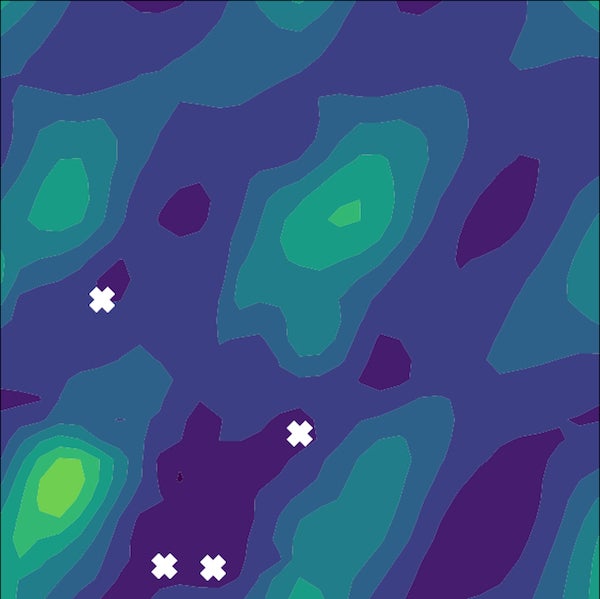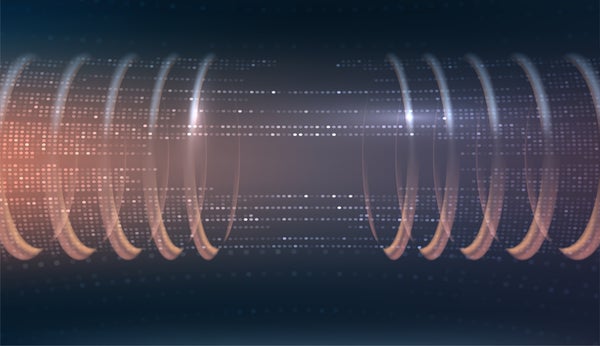This article was published in Scientific American’s former blog network and reflects the views of the author, not necessarily those of Scientific American
If you could look closely enough at the objects that surround you, zooming in at magnifications far beyond those you could ever see with most microscopes, you would eventually get to a point where the familiar rules of your everyday experiences break down. At scales where blood cells and viruses seem enormous and molecules come into view, things are no longer subject to the simple laws of physics that we learn in high school.
Atoms—and the electrons, protons and neutrons they are made of—don’t exist in the same way a marble does. Instead they are smeared in clouds that are difficult to understand and impossible to describe without the complex mathematics of quantum mechanics.
And yet atoms make up molecules, which, in turn, are the building blocks of marbles and everything else we touch and see each day. Nature has clearly found some way of suppressing quantum behavior when quantum objects are assembled into the familiar ones all around us.
On supporting science journalism
If you're enjoying this article, consider supporting our award-winning journalism by subscribing. By purchasing a subscription you are helping to ensure the future of impactful stories about the discoveries and ideas shaping our world today.
How can things that obey the classical laws of physics—such as a pitched baseball or a bumblebee in flight—be composed of parts that are subject to quantum rules at minute levels? That is one of the deepest questions in modern physics. In pursuit of an answer, recent research—with funding from the High Energy Physics program at the Department of Energy’s Office of Science—should help shed light on how the classical world emerges from the underlying quantum one.
A quantum-computing algorithm, developed by scientists at Los Alamos National Laboratory and the University of California, Davis opens a new window on the connection between the quantum and classical worlds and the transition that must occur as we zoom out from the smallest scales.
To study the quantum-to-classical transition, physicists need to evaluate how close a quantum system is to acting classically. Among other effects, physicists must consider the fact that quantum objects are subject to wave-particle duality. Things we often think of as particles, such electrons, can act like waves in some circumstances. And things we think of as waves, such as light, can act like particles, which are called photons. In a quantum system, the wavelike states of particles can interfere with one another in much the same way that ocean waves can sometimes add together or cancel one another out.
A quantum system lacking interference can be described using classical rules rather than quantum ones. The newly developed algorithm searches out interference-free solutions, known as consistent histories, which are those we ultimately observe in the classical world we inhabit.
For systems of a few atoms, finding consistent histories is fairly trivial. For systems made up of many pieces, however, quantum-to-classical transition calculations are notoriously difficult to solve. The number of equations involved grows drastically with each added atom. In fact, for systems of more than just a few atoms, calculations rapidly become intractable on even the most powerful supercomputers.

White crosses represent non-interfering quantum states that behave classically for a simple quantum problem analyzed with the consistent histories algorithm developed by the Los Alamos National Laboratory-UC Davis collaboration. This algorithm gives quantum computers the potential to overcome the challenges of studying the quantum-to-classical transition, which have stumped physicists for decades. Credit: Los Alamos National Laboratory
Appropriately enough, the new consistent-histories algorithm relies on a quantum computer to overcome the computational explosion and gauge how close to classical a quantum system is behaving. Unlike conventional computers that manipulate data made up of 1s and 0s, quantum computers store and manipulate data as quantum combinations of numbers. Similar to how an atom exists as a quantum cloud rather than at a single point, data in a quantum computer is not a single number but a superposition of many numbers.
While quantum computers powerful enough to solve meaningful problems don’t exist just yet, it has been theoretically shown that they can achieve remarkable calculations, performing, in principle, exponentially faster than conventional computers. Using the consistent-histories algorithm, quantum computers have the potential to tame the difficulties of studying the quantum-to-classical transition precisely because they operate under the same rules that govern atoms and other quantum entities—an elegant potential solution to a problem that has vexed physicists for decades.
